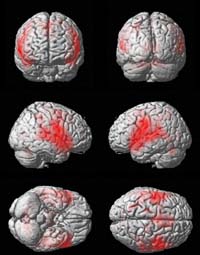By Dr Tom Weidig
*This page is more than 5 years old*
In August 2002, a news story on brain research into stammering made the headlines. A research team in Hamburg, Germany, claimed to have found a structural anomaly in a specific region of the left side of the brain of people who stammer. This is important news as it might shed some light on stammering. Therefore, I have decided to write this article for Speaking Out on the latest research findings. I review the progress made in research on the stammering brain, try to show you how it can fit into the complex nature of stammering, and speculate on possible applications to therapy. The views expressed in this article are my own and I encourage you to go through the reference material at the end of the article yourself.

Stammering is a highly complex phenomenon that exists on a social, psychological, behavioural and neurological level. Despite a century long effort, I think, it is fair to say that no-one really understands the underlying mechanism of stammering nor does anyone have a theory of stammering that can be and has been verified. The problem lies deeper than overt speech production, and probably involves language, speech planning and execution inside the brain. Unfortunately, until recently, there had been no useful tools available to study the living brain. But, it is now possible to look directly at the living brain in detail and a revolution in the understanding of the human brain is currently under way.
The two most important brain-imaging techniques are called PET and fMRI, and they detect increased blood flows: the more a brain region is activated, the more blood with energy is needed. PET was first used and produced the first clear pictures of the living brain. fMRI captures more spatial details with a shorter time exposure. The techniques are not prefect yet, but scanning machines are becoming increasingly powerful.
Three important principles, also relevant to stammering, have emerged from brain research. Firstly, the brain works on a highly modular basis, which means that different brain regions are responsible for different tasks. Secondly, the brain is constantly evolving to outside stimuli and a region will often take over other functions if another region fails. Thirdly, the origin of several 'psychological' conditions like clinical depression, Tourettes syndrome, dyslexia and others can now be directly traced back to a neurological or biochemical malfunctioning of the brain, and the psychological aspects of these conditions are viewed as an aggravating factor, or a consequence, rather than the underlying cause of the condition.
It is important to put the findings of the Hamburg group in perspective and look at past brain research. During the nineties, several groups looked directly at the stammering brain with PET scans, among them Ingham and Fox, Kroll and de Nil, Braun, and others. The techniques were not powerful enough to single out specific regions unambiguously, for example: motion during speech reduces the sharpness of the scans, and the difficulty to distinguish between causes and effects due to not-good-enough resolution and statistical methods.
However, the following observations are consistent across all studies. Firstly, at rest, the activation level of the brain of people who stammer is no different to the one of other people. Secondly, there are clear differences during speech in the activation levels in various regions. Thirdly, in comparison, the speech-dominant left brain of stammerers is less activated and the right brain is more activated. Fourthly, even during fluent speech of stammerers, there are differences in activation, but they are less significant.
But, are the different activation levels of some regions cause or effect of stammering? For example, the auditory cortex seems to be under-activated. But does this brain region switch off due to the constant stammering noise (like living next to a motorway!)? Or is stammering partially caused due to lower auditory feedback? Or is it a combined effect i.e. the brain region switches off due to noise and this effect makes stammering worse and harder to treat? But, with the right imaging technique, the effects could be filtered out, because everyone stammers in a different way and therefore different regions are activated. So only regions that are consistently over or under-activated in all people who stammer and not in the fluent people could qualify as a cause. Of course, this only applies if there is a common underlying cause for all stammerers.
The research published in the August 2002 edition of 'The Lancet' is a good example of the latest brain research being driven by new powerful brain imaging technologies. Unlike past PET studies, the Hamburg scientists did not study brain activation, but used a MRI technique called DTI to measure the diffusion of water through brain tissue. They looked for regions of the brain which have a significantly different fibre structure for stammerers as compared to fluent subjects. Tracts of fibres contain millions of long connecting arms, the axons, transmitting electric signals between nerve cells. These axons can only transmit signals if an insulating lining called myelin covers them. A coherent and dense arrangement of axons ensures stable signal transmission. For example, the corpus callosum, the fibre tract connecting the two brain halves, has a high directional coherence and density of axons. Researchers believe that the diffusion of water through fibre tracts relates directly to the coherence of the axon arrangement. Thus, the DTI seems to measure the quality of the transmission, like the level of background noise in a phone line.
The Hamburg scientists found a region whose diffusion is consistently lower in people who stammer. It is the rolandic operculum in the left brain and it is a speech-related region. The results point to a structural weakness. They conclude that stammering might be caused by disturbed signal transmission through the rolandic operculum connecting parts of the brain used for speech articulation and planning. Distributed signal transmission points towards a timing disconnection of language and speech-related regions. Their findings are consistent with other research that shows timing disturbances between areas involved in language preparation and execution. It also fits into research by Foundas et al. of anatomical differences in close-by areas. The observed right brain over-activation is also a compensation for the rolandic operculum malfunctioning. They further suggest that fluency enhancing techniques like chorus reading are successful, because they provide an external clock that allows all brain regions to synchronize language and speech processes. This synchronization should happen anyway, but the rolandic operculum fails to efficiently transmit signal to synchronize internally. And, they believe that the physical difference in the rolandic operculum is not a consequence of stammering, but at its origin.
The brain scientists further speculate that a low coherence in the fibre structure originates either from errors during the formation of the myelin lining or a failure to develop a higher density of axons in the left rolandic operculum during early childhood. During the first years of childhood, the brain switches on more and more brain regions like speech, planning or self-control centres; as it learns to speak, plan ahead and exercise self-control. And, a gene might very well influence the occurrence of the defect, and this fits recent gene research.
To summarise, their research looks scientifically solid to me, but it certainly needs to be independently verified by other groups and some of their speculative statements might turn out to be wrong. Building on past research, they have put forward a theory of stammering into the testable area and that is major progress.
Let us now assume that their research findings are correct and the left rolandic operculum is not functioning well. What is the most likely mechanism for stammering? My theory is that another brain region in the right brain must have taken over a compensatory role, because people who stammer are capable of speaking fluently. This compensatory system corrects for errors and is more sensitive to interference from other brain activities. The compensatory region probably often suffers from work overload during stress and emotionally or grammatically difficult speech. The stammering symptoms like blocks, reduced auditory feedback, fillers, avoidance and fears are learned behaviours from childhood disfluency. They reinforce and make stammering much worse, and behaviours are difficult to unlearn.
Undoubtedly, increasing sophistication in brain imaging is driving the research and will soon lead to more experimental results. For example, I am in contact with a brain research team in Frankfurt, Germany. They have access to a powerful fMRI scanner and use a methodology to correct for motion-related effects. Their resulting brain scans are superior and the group should be able to localise a compensatory region only consistently activated in people who stammer, if it exists. But, it is important to stress that research is never straightforward and nature often turns out to be rather different than anyone had thought.
Can the latest results lead to better therapies? This is a difficult question. Firstly, people who stammer do not only have to deal with their speech impediment, but also with the uncertainty surrounding stammering. In my opinion, the evidence that a neurological disorder is the originating cause of stammering is now very compelling and would put things into perspective.
Secondly, stammering is a very complex condition, and behavioural and psychological factors contribute greatly towards the impediment that stammering causes. The interesting question to ask is whether a clear improvement on a neurological level automatically makes behavioural and psychological effects disappear slowly, but surely. The large number of relapses of speech therapy shows how strong behavioural factors are and tackling their feeding source might be the way forward.
Thirdly, a theory of stammering might give therapists more concrete clues on how to improve therapies. Let us assume that the Hamburg results are correct and further assume that stammering is due to a compensatory system sensitive to interferences. I cannot see how to un-do the structural anomaly found by the Hamburg team. So I would guess that the goal should be to strengthen the compensatory system through constant targeted exercise and make it immune under stress. The exercises could consist of focused speech exercises, but also silent brain training of the important regions is possible. Thus, this probably does not look that different to current speech therapy, but the attention can now be directly focused on the compensatory system and be based on solid research findings. Of course, it is early days to speculate on an application to therapy.
To summarise, brain research into stammering is a fast moving research field driven by technology and methodology advances. The Hamburg findings indicate that a neurological structural anomaly is probably the basis of stammering and current research tries to untangle the exact mechanism. Future research also needs to reproduce their experiment and test their theory of stammering. Due to the complex nature of stammering, an application to therapy is not straightforward, but there is no doubt in my mind that a better understanding of stammering from brain research is the best possible way forward towards more efficient therapy with fewer relapses. Every breakthrough in any field has been marred by setbacks, errors and delays. The key to success is to never ever give up! If we keep on researching, we will end up in a world that understands stammering and offers better therapy outcome.
Reference Material:
- "Mapping The Mind" by Rita Carter - an excellent introduction to brain research and the revolution of the understanding of the human brain.
- "Neural Bases of Stuttering and its Treatment" by Robert Kroll and Luc de Nil.
- "The Brains of Adult Stutterers: Are They Different from Non-stutterers?" by Janis Ingham and Roger Ingham, see International Stuttering Awareness Day 2002 Online: www.mnsu.edu/comdis/isad5/papers/ingham.html
- "Some Keys To Understanding Stuttering and its Management" by Prof. Webster, Speaking Out Autumn 1996.
- "Studying stuttering from a neurological and cognitive information processing perspective" by Hans-Georg Bosshardt and Luc de Nil, proceedings of Third IFA World Congress.
- "Are the Brains of People Who Stutter Different?" by Anne L. Foundas, MD
- I would to thank Christine Preibisch for providing me with the brain scans. I also thank Katrin Neuman, Luc de Nil, the members of the BSA research committee and Andrew Harding for useful discussions on brain research or feedback.
From the Winter 2002 edition of our old magazine Speaking Out.




























